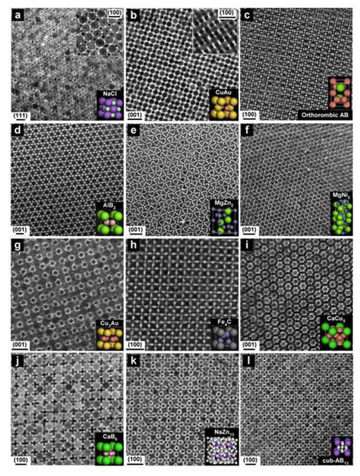New Nanotechnological Structures Reported for the First Time

A team of Columbia University and IBM scientists has created conditions necessary for the successful self-assembly of new nanotechnological structures -- at least 10 novel crystal arrangements that could form the basis of tomorrow's leading edge technology, the journal Nature reported in its Jan. 5, 2006 edition.
This scientific breakthrough provides a simpler, less costly method of generating new structures, helping scientists "grow" ordered superlattice crystals, as opposed to manipulating or "machining" them.
Nanotechnology, a scientific field in which the placement of specific atoms or molecules on the scale on nanometers (one billionth of a meter), allows for the assembly of unique structures that have a wide range of manufacturing and technological implications -- from magnetic storage in computer hard drives to surgical robotics to a number of defense-related technologies.
The findings of Stephen O'Brien, professor of applied physics and applied mathematics and a key member of the Materials Research Science and Engineering Center (MRSEC) at Columbia, along with Columbia postdoctoral research scientist Elena Shevchenko, were published in the Jan. 5, 2006, issue of Nature . MRSEC is an interdisciplinary team of university, industry and national laboratory scientists working together to develop new types of nanocrystals and ways of assembling them into thin films. The work on new structures was conducted in conjunction with Dmitri Talapin and Christopher Murray at the IBM Watson Research Center in Yorktown Heights, New York, and was supported by the National Science Foundation and the New York State Office of Science, Technology and Academic Research.
"You can think of nanocrystals as building blocks like the toy Lego, in which a larger structure can be assembled by locking in the pieces according to their shape and the way they prefer to join to each other," O'Brien says. "Except all of this is on an incredibly small lengthscale -- billionths of a meter."
The Columbia/IBM team has borrowed ideas from the natural world, in which the right conditions can stimulate the slow growth of highly uniform structures out of miniature building blocks. Opals are an example of this phenomenon: opals consist of tiny spherical building blocks of silica packed into an ordered structure. In this new research, the materials used as building blocks are a variety of man-made nanocrystals with known useful magnetic or electronic properties.
"This work may lead to the development of an entirely new class of multifunctional materials in which there are cooperative interactions between the nanocrystal components," says MRSEC director Irving P. Herman, also a professor of applied physics. "Moreover, the properties of these nanocrystals can be tailored during synthesis, and they can be deposited to form the desired ordered array by controlling particle charge and other properties. O'Brien's study also demonstrates the value of vibrant collaborations between universities and industry."
Said O'Brien, "This work could not have been achieved without the outstanding level of input and cooperation from the whole team. IBM's attitude toward collaborative research has been exceptional."
Source: Columbia University (By Alex Lyda)

















